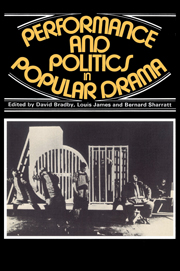 Performance and Politics in Popular Drama
Performance and Politics in Popular Drama Book contents
- Frontmatter
- Contents
- List of contributors
- Preface
- Acknowledgements
- PART ONE Spectacle, performance and audience in nineteenth-century theatre
- Introduction
- Was Jerrold's Black Ey'd Susan more popular than Wordsworth's Lucy?
- Word and image in Pixérécourt's melodramas: the dramaturgy of the strip-cartoon
- Joseph Bouchardy: a melodramatist and his public
- The music of melodrama
- Popular theatre in Victorian Birmingham
- Water drama
- Equestrian drama and the circus
- Theatre of war: the Crimea on the London stage 1854–5
- Popular drama and the mummers' play
- PART TWO Politics and performance in twentieth-century drama and film
- PART THREE Problems and prospects
- Appendix: Tempo, Tempo
- Select bibliography
- General index
- Index of titles of plays, films, sketches
- Index of theatres, theatre companies and groups
Equestrian drama and the circus
Published online by Cambridge University Press: 08 March 2010
- Frontmatter
- Contents
- List of contributors
- Preface
- Acknowledgements
- PART ONE Spectacle, performance and audience in nineteenth-century theatre
- Introduction
- Was Jerrold's Black Ey'd Susan more popular than Wordsworth's Lucy?
- Word and image in Pixérécourt's melodramas: the dramaturgy of the strip-cartoon
- Joseph Bouchardy: a melodramatist and his public
- The music of melodrama
- Popular theatre in Victorian Birmingham
- Water drama
- Equestrian drama and the circus
- Theatre of war: the Crimea on the London stage 1854–5
- Popular drama and the mummers' play
- PART TWO Politics and performance in twentieth-century drama and film
- PART THREE Problems and prospects
- Appendix: Tempo, Tempo
- Select bibliography
- General index
- Index of titles of plays, films, sketches
- Index of theatres, theatre companies and groups
Summary
The term ‘equestrian drama’ means a play enacted by horses and riders, usually presented both in the ring and on the stage of a permanent amphitheatre. It is basically a bastard entertainment, the result of a misalliance between the theatre and the circus, two types of spectacle whose fundamental principles are very different. The offspring did enlarge the base line of the theatre although, in this country, I submit it actually inhibited the development of the circus. But before we consider this naive, colourful, melodramatic and, above all, popular entertainment, I would like to deal briefly with the basic characteristics and relevant history of the parent spectacles, particularly those concerning the circus. Whereas the underlying principles of the theatre have been discussed ever since Aristotle set out his Unities, few have attempted to analyse the attributes of the circus. One, however, who has published a critical comparison of stage and ring spectacles is Pierre Bost, whose study fifty years ago led me to try to develop the basic principles he laid down.
In the traditional theatre the audience is confronted with makebelieve on the stage. The spectacle is seen against a representational background. Go backstage and the illusion is lost; all you will see is the plain, ungilded, reverse side of the proscenium and unpainted canvas. It is like looking at the back of a picture. In the circus there is no scenery, no backstage; the spectacle can be seen from all sides, like sculpture. Because the audience holds the spectacle in its midst, there are eyes all round to see that there is no make-believe.
- Type
- Chapter
- Information
- Performance and Politics in Popular DramaAspects of Popular Entertainment in Theatre, Film and Television, 1800–1976, pp. 109 - 118Publisher: Cambridge University PressPrint publication year: 1980
- 3
- Cited by
